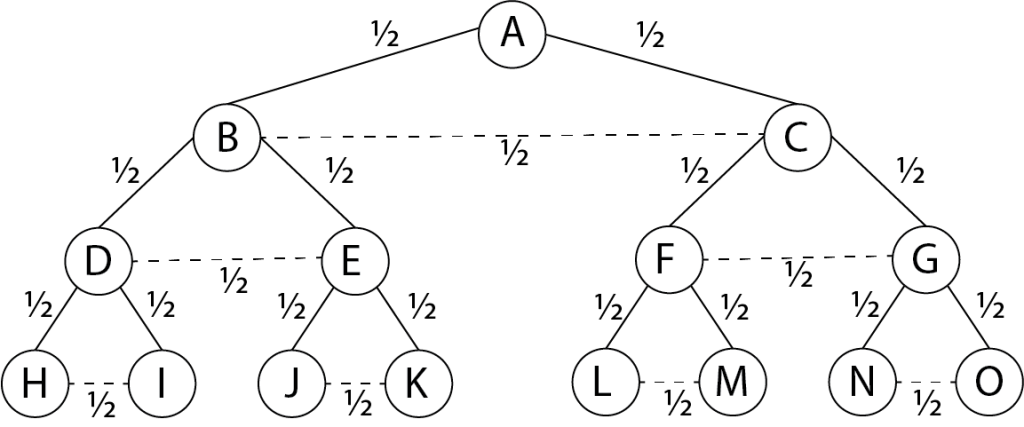PRACTICE: Hamilton’s Rule
To calculate Hamilton’s Rule, we must first know the coefficient of relatedness (r). To find this, we identify two members on a kinship chart and multiple the relatedness. For example, to find the relatedness of A and D in the figure at the bottom of this page, we would multiply 0.5 for the distance between A and B by 0.5 for the distance between B and D.
0.5 * 0.5 = 0.25
Here we see, the coefficient of relatedness between A and D is 0.25.
As a general rule, parents and offspring are 0.5 related to each other. This makes sense since we get half our DNA from mom and the other half from dad. We are also 0.5 related to our full, biological siblings. We are 0.25 related to our grandparents, nieces, nephews, aunts and uncles, and we are 0.125 related to our cousins.
Once we know the coefficient of relatedness, we next determine the benefit to the recipient of the act. Let’s say your sister (r = 0.5) needs you to buy her groceries this week. If you refuse, she has a 70% chance of starving. Since you just received your paycheck and have paid your bills, it is of minimal cost to you to do so – say, 15%. Plugging this into Hamilton’s Rule, we get the following:
0.5 * 0.7 > 0.15
Since 0.35 > 0.15, you should buy your sister some groceries.
Practice
Using the chart below, answer the following questions:
- What is the coefficient of relatedness between C and M? click here for the answer.
- What is the coefficient of relatedness between A and K? click here for the answer.
- If A needs a lifesaving surgery (B = 1.0), would Hamilton’s Rule suggest K help if there is a 32% risk of complications to E’s health? click here for the answer.

a measure of the degree of biological relationship between two individuals.
C to F is 0.5
F to M is 0.5
0.5 * 0.5 = 0.25
A to B is 0.5
B to E is 0.5
E to K is 0.5
0.5 * 0.5 * 0.5 = 0.125
First, find the coefficient of relatedness for A and K. Per the previous question, we know that is 0.125.
r = 0.125 - coefficient of relatedness
B = 1.0 - benefit to recipient of the cost
C = 0.32 - cost to the actor
0.125 * 1.0 = 0.125
0.125 is not greater than 0.32
Therefore, Hamilton would argue that A should not risk helping K.

